
|
Sale 36
Pre-Long Beach Coin and Currency Auction
| Lot |
Photo |
Description |
Realized |
Lot 3905 |
 |
1797 $10 Capped Bust. Large eagle. Sharpness of AU-50 Taraszka-8, Rarity 4. Light hairlines from an old cleaning and some scratches in the obverse field before the cap. Traces of mint luster and lightly toned. A refreshingly original coin with some luster, as mentioned, still evident after the cleaning, and pleasing champagne-gold to pale coppery orange toning that seems to want to motivate bidders to increase their bids. The devices are resolutely struck including sharp rim dentils, with the characteristic die break through the second 7 in the date.
When the quarter eagle went into production for the first time, in 1796, it bore the same obverse as on the eagle and half eagle, but a new reverse, generally described as the heraldic eagle since its origin was the Great Seal of the United States, our version of the heraldry seen in European capitals. The newly styled coin bears a somewhat more full-featured eagle than on the smaller denominations. The eagle faces to the left and holds in its beak a ribbon inscribed E PLURIBUS UNUM, a Latin phrase meaning One Among Many. A shield is set on the eagle's breast. The eagle holds a bundle of arrows in its right talons (the viewer's left) and an olive branch in its left talons. UNITED STATES OF AMERICA surrounds the design, as on the small eagle 1797. A semicircle of clouds stretches from wing to wing, with 13 stars positioned between the clouds and the eagle in arrangements that vary from die to die. There is no denomination indicated. Size and weight alone told the owner its denomination.
Mint engraver Robert Scot's new reverse was introduced on the eagle in mid-1797, so eagles of this year are found with both reverse design types. The estimated mintage of the 1797 capped bust, heraldic eagle $10 is 10,940.
Estimated Value $14,000 - 16,000.
Ex: From Stack's June 18-19, 1981 Sale. Lot 771.
View details and enlarged photos
| Realized
$23,000 |
Lot 3906 |
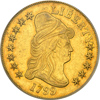 |
1799 $10 Capped Bust. Small obverse stars. PCGS graded AU-58 Taraszka-19. Well struck with nice light golden toning. A very tiny dig by the U of UNITED and another, smaller ding above B in LIBERTY and another on the cheek, these being the only two perceptible marks on an otherwise smooth surface. Desirable with this precision strike, all stars are full, as are the cap and Liberty's hair waves. Lustrous fields and devices.
This obverse die has an unusual date layout dubbed the Irregular Date by Walter Breen. The distance between the bust and final 9 is much less than the distance between the hair curl and 1. All other 1799 obverse dies have the opposite layout, with the digit 1 much closer. The first two numerals lean far to the right Pop 17; 46 fiiner. (PCGS # 98562) .
Estimated Value $20,000 - 24,000.
View details and enlarged photos
Check results on similar lots
| Unsold |
Lot 3907 |
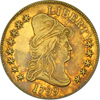 |
1799 $10 Capped Bust. Small obverse stars. PCGS graded AU-50 Taraszka-20. Old green holder. Nice strike with irregular gold toning. Semi reflective fields. Pop 53. This is a splendid early Eagle specimen with ample toning that is most predominant on the obverse butr also gives a fine show of itself on the reverse. Well struck for the date, certainly much better-quality than similar high-end examples offered in recent years; we find it worthy of strong bidder attention.
This is the 1799 Irregular Date obverse die. In combination with this reverse the die marriage is quite scarce. Possibly 50 to 60 examples survive from this die marriage. The reason for it being scarce is not always easy to explain but the fact remains, this was a short-lived reverse die, only known to exist in this single T-20 die marriage. There is no simple explanation for the longevity of individual dies. Some dies are known in several marriages with many hundred coins surviving. Others such as this were only used for a single combination and, when they broke, were discarded (PCGS # 8562) .
Estimated Value $12,000 - 14,000.
View details and enlarged photos
Check results on similar lots
| Realized
$17,825 |
Lot 3908 |
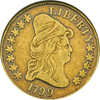 |
1799 $10 Capped Bust. Large obverse stars. NGC graded. VF-25 Taraszka-22. Light even toning with nice even wear. Scattered old circulation marks in the hair and cap as well as in the fields. A high degree nice original toning springs to life on top of the "old gold" foundation of this early $10 gold piece. Somewhat soft at the reverse shield at center, though much more detail can be found there than on the typical example of the date (PCGS # 8562) .
Estimated Value $7,000 - 8,000.
View details and enlarged photos
Check results on similar lots
| Realized
$13,225 |
Lot 3909 |
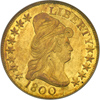 |
1800 $10 Capped Bust. PCGS graded MS-61 Mint Error, Double Struck. Spectacular double strike most notible on the reverse (see shield), doubling can be seen on both sides. A fully original coin with luster present and natural greenish rose overtones. B. 1-A, Taraszka-23, the only known dies, Rarity-4. The 1800 has an original mintage of just 5,999 coins, with survivors much rarer than those of the 1795, 1797 Heraldic Eagle, 1799, 1801, and 1803. The 1796 and 1804 are rarer, if only just barely. The present example is considerably finer than the typically offered Very Fine to About Uncirculated example. Plus, it has a bonus, it is double struck! And not just faintly double struck, but noticeably so. An incredibly rare offering.
The otherwise frosty textured surfaces exhibit modest, yet appreciable hints of brightness in the fields. The color is a rich and fresh. All features are uncommonly well struck for a product of the First Philadelphia mint including the stars on the obverse, all stars on the reverse, the eagle and shield with the exception of where the overlapping image shows. The usual adjustment marks which often imperil the grade on these are completely absent. Struck from a late die state, there are numerous branching obverse die cracks (also as struck) along the tops of the letters in LIBERTY. A remarkable coin! (PCGS # 8563) .
Estimated Value $50,000 - 55,000.
View details and enlarged photos
Check results on similar lots
| Realized
$66,125 |
Lot 3910 |
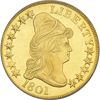 |
1801 $10 Capped Bust. PCGS graded MS-64 T-25, Rarity 3. An intensely lustrous bright golden-yellow. Problem-free planchet. A beauty. Pop 35; 2 in 65. Well preserved with smooth, velvety luster and rich yellow-gold features, a superlative coin for the grade now matter how you look at it. A great deal of discussion also surrounds a coin's strike. This is especially important on an early Eagle struck in the opening years of the Mint. The 1801 presented here has excellent detail with no sign of weakness to the centers. The stars, too, are outstanding and bold. Liberty's hair shows bold smooth waves and includes the uniquely designed forehead roll of hair, plus nice folds and artistically formed "mob" cap on her head. The hair and cap come together nicely at the back so that one is never sure where the cap ends and the hair begins. Are those strands of hair looped up over the front of the cap? Again, this is a very attractive design. Nor is the coin waylaid by anything like marks, adjustment lines, or rim bruises; nothing of the kind, everything is outstanding.
Robert Scot's designs for the $10 gold piece copied those of the quarter eagle. Liberty's draped and capped effigy continued from 1795-97; the heraldic eagle derived from that of the Great Seal of the United States, but with the same blunder as on the smaller denominations: The warlike arrows are in the dexter or more honorable claw, outranking the olive branch for peace (PCGS # 8564) .
Estimated Value $70,000 - 80,000.
View details and enlarged photos
Check results on similar lots
| Realized
$109,250 |
Lot 3911 |
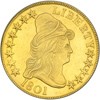 |
1801 $10 Capped Bust. PCGS graded MS-63 Taraszka-25. Well struck with a hint of light gold toning. Great eye appeal. This is a thickly frosted, bright yellow gold quality representative of a desirable early $10 Eagle Type. What is most unusual about it is the clockwork precision seen in the hair curls, the cap folds, and all of the heraldic eagle with its complex design. Only a few stars are rounded on the obverse (a common occurrence). There is an identifying light hairline in the reverse field from T of UNITED to the edge of the shield that can be used in tracing this coin's provenance in the future. All else is bright and glistening, a coin with spectacular eye appeal given the usual humdrum quality seen on most early $10 gold pieces. (This is a strike made before the dies clashed, leaving residual "bars" from the shield on the upper part of the cap.) Pop 34; 35 in 64; 2 in 65. (PCGS # 8564) .
Estimated Value $40,000 - 45,000.
View details and enlarged photos
Check results on similar lots
| Realized
$60,375 |
Lot 3912 |
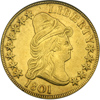 |
1801 $10 Capped Bust. NGC graded AU-58 T-25. Untoned. Only 44,344 minted. Pop 75. Amazing choice surfaces for the type, the luster, much of which still remains, is alive with rich "old gold" color. Nicely struck for the variety, which is typical for T-25 in having some raised lines from the shield as "die clash" in Liberty's cap. The reverse details are just as boldly struck as those on the obverse. Fully struck coins of this type are desirable (PCGS # 8564) .
"To the shores of Tripoli." There is at the moment a lot of discussion about undeclared wars. America's first such undeclared war took place in 1801, the year of this gold eagle. Conflict with the North African port city of Tripoli began when the Pasha of Tripolitania cut down the flagpole at the U. S. Consulate, a major diplomatic insult, after the U. S. refused to pay tribute to pirates along the Barbary Coast. Later, on the night of February 16, 1804, Lieut. Stephen Decatur and his daredevil crew, with the full permission of President Jefferson, slipped aboard the captured American ship Philadelphia as it lay docked in Tripoli harbor, knifed the guards, set the ship afire by using gunpowder, and rowed safely away. Finally, in 1805, the U. S. consul in Tunis, William Eaton, collected a rabble army in Egypt-consisting of 38 Greeks, 300 Arabs, a dethroned pasha, and 7 marines under Lieut. Preston N. O'Bannon, and marched 600 mile across the desert to attack Tripoli from the rear. The phrase "To the shores of Tripoli" in the U. S. Marines' hymn refers to this incident.
Estimated Value $18,000 - 20,000.
View details and enlarged photos
Check results on similar lots
| Unsold |
Lot 3913 |
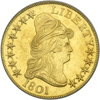 |
1801 $10 Capped Bust. PCGS graded AU-58 PQ, T-25 Rarity 3. Well struck and untoned. Mint luster still evident. Some minor marks in the obv fields otherwise a few points higher. Pop 57. A sharp impression was left by the recoil of the dies that struck this 1801 early eagle, and it is fascinating to study the devices since they are so deeply struck as to cause amazement in a person whose general knowledge does not encompass the knowledge of the early Mint, nor its ability to strike such a sharp, balanced coin. At the time the first gold coins were issued in 1795, the Mint settled upon the six-pointed star, principally because of its heraldic associations. Its geometric design and features greatly appealed to the aesthetic sense, and can be seen for all they are worth on this beautiful $10 gold eagle (PCGS # 8564) .
Estimated Value $18,000 - 20,000.
The Emile A. Tartakow Collection.
View details and enlarged photos
Check results on similar lots
| Realized
$33,350 |
Lot 3914 |
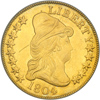 |
1804 $10 Capped Bust. PCGS graded MS-61 Taraszka-31, Crosslet 4. Very rare date. Small obv scratch in the left obv field. Nicely toned. Normal amount of adjustment marks. The 1804 is the final year of the early $10 Type, and is also one of the more elusive issues in the series of heraldic eagle tens. For one thing, the mintage was low: 3,757 pieces were originally produced. The striking characteristics of this piece are fairly typical for the issue, with softly defined facial features at the eye, nose and chin, minor weakness on the inner points of star 12 and several others, and bluntness on the interior of the eagle's right wing at right and the associated edge of the shield. The hair curls, however, are well defined, indeed nicer than usually seen, while and the eagle's breast feathers are almost fully complete. There is the aforementioned line in the field from the fourth star to the lower cap, as well as adjustment marks in the hair and at Liberty's chin. Both sides display glowing luster and lovely reddish gold accents. Pop 5; 4 finer; 2 in 62; 2 in 63. (PCGS # 8566) .
Estimated Value $70,000 - 80,000.
View details and enlarged photos
Check results on similar lots
| Realized
$86,250 |
|
|